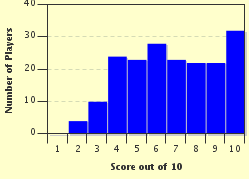Quiz Answer Key and Fun Facts
1. Born in Lincolnshire in 1703, this one-time Anglican priest and theologian is honored with the pictured statue in Saint Paul's Cathedral, a copy of which stands in Methodist Central Hall in Westminster. He was the chaplain on the expedition led by James Oglethorpe to North America, which established the colony of Georgia. Who is he?
2. Born in 1709, the pictured statue of this writer stands opposite his birthplace in the Staffordshire cathedral city of Lichfield. Although his contribution to Georgian-era literature is immense, it is perhaps as the subject of one of the greatest biographies ever written that he is best remembered. Who is this?
3. Born in the historic county of Northumberland in northern England in 1716, Capability Brown was a landscape architect described as "England's greatest gardener". He designed gardens and parks throughout the country, including the grounds of the pictured Petworth House in Sussex, home today to the country's largest herd of fallow deer. "Capability" was not his real first name, though. What was?
4. Born in the city of Hereford in 1717, this actor, playwright and theatrical manager influenced 18th-century theater in England more than anyone else. He is depicted in works of art by numerous famous painters: William Hogarth painted him more than once, including the pictured work showing him with his wife, Eva Marie Veigel. Who is this great Englishman?
5. In the market town of Otley, part of the Leeds metropolitan area in West Yorkshire, stands the pictured statue of England's greatest Georgian-era cabinet-maker, who was born here in 1718. Known for designing furniture in English rococo and neoclassical styles, his 1754 book was used as a template by most other cabinet-makers of the era. Who was this?
6. Born in 1723 in the ancient stannary town of Plympton, now a suburb of Plymouth in Devon, he is renowned as one of the greatest English portrait painters. Like many artists, he painted numerous self-portraits, including the pictured one which dates to around 1780. Knighted in 1769, he was a founder and the first President of the Royal Academy of Arts. Who is this artist?
7. Born in Liverpool in 1724, this artist is best-known for paintings in a particular genre. The pictured work is a self-portrait painted between 1765 and 1775 and now part of the collection at the National Gallery in London. The Tate, the Royal Collection and the National Museums Liverpool all contain numerous examples of his work. Who is this artist?
8. Born in 1728 in the village of Marton-in-Cleveland, now a suburb of Middlesborough, he became one of the great explorers of the 18th century. The pictured statue stands in Hyde Park in Sydney, Australia, but there are also statues of him in Greenwich in London, in Saint Kilda in Victoria, Australia, and in Waimea in Hawaii. Who is this great Englishman?
9. Born in Middlesex, London in 1732, his official title was the 2nd Earl of Guildford although that is not the name by which he is best known. He served 36 years as the Member of Parliament for Banbury in Oxfordshire and became Prime Minister in 1770. It was on his watch that Great Britain lost its American colonies and, in 1782, he became the first PM to be forced out of office following a vote of no confidence. Who is this Prime Minister?
10. Born in Norfolk in 1737, he became a political activist, a revolutionary, and one of the "Founding Fathers" of the U.S.A. The pictured statue stands in his birthplace: the plaque reads "World Citizen, Englishman by Birth, French Citizen by Decree, American by Adoption". Who is this?
Source: Author
EnglishJedi
This quiz was reviewed by FunTrivia editor
bloomsby before going online.
Any errors found in FunTrivia content are routinely corrected through our feedback system.

